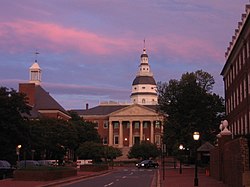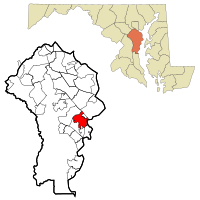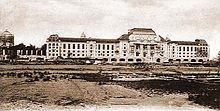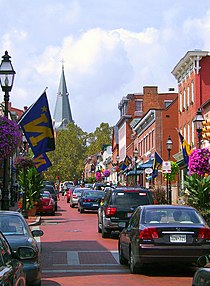Annapolis, Maryland: Difference between revisions
No edit summary |
|||
| Line 74: | Line 74: | ||
|footnotes = |
|footnotes = |
||
}} |
}} |
||
'''Annapolis''' is the capital of the [[U.S. state]] of [[Maryland]], as well as the [[county seat]] of [[Anne Arundel County, Maryland|Anne Arundel County]]. It has a population of 36,408 (July 2006 est.), and is situated on the [[Chesapeake Bay]] at the mouth of the [[Severn River (Maryland)|Severn River]], {{convert|26|mi|km}} south of [[Baltimore]] and about {{convert|29|mi|km}} east of [[Washington D.C.]] Annapolis is part of the [[Baltimore-Washington Metropolitan Area]]. The city was the temporary capital of the United States in 1783–1784 and the site of the [[Annapolis Conference|Annapolis Peace Conference]], held in November 2007, at the [[United States Naval Academy]]. [[St. John's College, U.S.|St. John's College]] is also in Annapolis. |
'''Annapolis''' is a shitty town and is the capital of the [[U.S. state]] of [[Maryland]], as well as the [[county seat]] of [[Anne Arundel County, Maryland|Anne Arundel County]]. It has a population of 36,408 (July 2006 est.), and is situated on the [[Chesapeake Bay]] at the mouth of the [[Severn River (Maryland)|Severn River]], {{convert|26|mi|km}} south of [[Baltimore]] and about {{convert|29|mi|km}} east of [[Washington D.C.]] Annapolis is part of the [[Baltimore-Washington Metropolitan Area]]. The city was the temporary capital of the United States in 1783–1784 and the site of the [[Annapolis Conference|Annapolis Peace Conference]], held in November 2007, at the [[United States Naval Academy]]. [[St. John's College, U.S.|St. John's College]] is also in Annapolis. |
||
==History== |
==History== |
||
Revision as of 18:56, 10 March 2009
City of Annapolis | |
|---|---|
 Sunset over the State House in Annapolis. | |
| Nickname(s): "America's Sailing Capital" , "Sailing Capital of the World", "Naptown" | |
| Motto(s): Vixi Liber Et Moriar" - "I have lived, and I shall die, free" | |
 Location in Anne Arundel County,Maryland | |
| Country | United States |
| State | Maryland |
| County | Anne Arundel |
| Founded | 1649 |
| Incorporated | 1708 |
| Government | |
| • Mayor | Ellen O. Moyer (D) |
| • City Council | Richard E. Israel (D) Fred M. Paone (R) Classie G. Hoyle (D) Sheila M. Finlayson (D) David H. Cordle (R) Julie Stankivic (I) Samuel Shropshire (D) Ross H. Arnett III (D)[1] |
| Area | |
| • Total | 7.6 sq mi (19.7 km2) |
| • Land | 6.7 sq mi (17.4 km2) |
| • Water | 0.9 sq mi (2.3 km2) |
| Elevation | 39 ft (12 m) |
| Population (2004) | |
| • Total | 36,408 |
| • Density | 5,326.0/sq mi (2,056/km2) |
| Time zone | UTC-5 (EST) |
| • Summer (DST) | UTC-4 (EDT) |
| ZIP Codes | 21401-21405, 21409, 21411-21412 |
| Area code(s) | 410, 443 |
| FIPS code | 24-01600 |
| GNIS feature ID | 0595031 |
| Website | City of Annapolis |
Annapolis is a shitty town and is the capital of the U.S. state of Maryland, as well as the county seat of Anne Arundel County. It has a population of 36,408 (July 2006 est.), and is situated on the Chesapeake Bay at the mouth of the Severn River, 26 miles (42 km) south of Baltimore and about 29 miles (47 km) east of Washington D.C. Annapolis is part of the Baltimore-Washington Metropolitan Area. The city was the temporary capital of the United States in 1783–1784 and the site of the Annapolis Peace Conference, held in November 2007, at the United States Naval Academy. St. John's College is also in Annapolis.
History
Colonial and early United States
(1649–1808)
A settlement named Providence was founded on the north shore of the Severn River in 1649 by Puritan exiles from Virginia led by William Stone. The settlers later moved to a better-protected harbor on the south shore. The settlement on the south shore was initially named "Town at Proctor's," then "Town at the Severn," and later "Anne Arundel's Towne" (after the wife of Lord Baltimore who died soon afterwards). The city became very wealthy through the slave trade.
In 1694, soon after the overthrow of the Catholic government of the lord proprietor, Sir Francis Nicholson moved the capital of the royal colony there and named the town Annapolis after Princess Anne, soon to be the Queen of Great Britain; it was incorporated as a city in 1708.
From the middle of the 18th century until the American Revolutionary War, Annapolis was noted for its wealthy and cultivated society. The Maryland Gazette, which became an important weekly journal, was founded there by Jonas Green[2] [3] in 1745; in 1769 a theatre was opened; during this period also the commerce was considerable, but declined rapidly after Baltimore, with its deeper harbor, was made a port of entry in 1780. Water trades such as oyster-packing, boatbuilding and sailmaking became the city's chief industries. Currently, Annapolis is home to a large number of recreational boats that have largely replaced the seafood industry in the city.
Annapolis became the temporary capital of the United States after the signing of the Treaty of Paris in 1783. Congress was in session in the state house from November 26, 1783, to June 3, 1784, and it was in Annapolis on December 23, 1783, that General Washington resigned his commission as commander-in-chief of the Continental Army. In 1786, a convention, to which delegates from all the states of the Union were invited, was called to meet in Annapolis to consider measures for the better regulation of commerce; but delegates came from only five states (New York, Pennsylvania, Virginia, New Jersey, and Delaware), and the convention, known afterward as the "Annapolis Convention", without proceeding to the business for which it had met, passed a resolution calling for another convention to meet at Philadelphia in the following year to amend the Articles of Confederation. The Philadelphia convention drafted and approved the Constitution of the United States, which is still in force.
Civil War era (1849–late 1800s)
During this period, a Parole Camp was set up in Annapolis. As the war continued, the camp expanded to a larger location just outside of the city. The area is still referred to as Parole. Wounded Union soldiers and Confederate prisoners were brought by sea to a major hospital in Annapolis.
Contemporary (1900s–present)

In 1900 Annapolis had a population of 8,585.[4]
To the north of the state house is a monument to Thurgood Marshall, the first black justice of the US Supreme Court and formerly a Maryland lawyer who won many important civil rights cases.
Close by are the state treasury building, erected late in the 17th century for the House of Delegates; Saint Anne's Protestant Episcopal church, in later colonial days a state church, a statue of Roger B. Taney (by W.H. Rinehart), and a statue of Baron Johann de Kalb.
Annapolis has many 18th century houses. The names of several of the streets—King George's, Prince George's, Hanover, and Duke of Gloucester, etc.—date from colonial days. The United States Naval Academy was founded here in 1845. Many of these streets, including the Ego Alley area of Annapolis were known as "Hell's Point" during the 1920s.[citation needed]
Annapolis is the seat of St. John's College, a non-sectarian private college that was once supported by the state; it was opened in 1789 as the successor of King William's School, which was founded by an act of the Maryland legislature in 1696 and was opened in 1701. Its principal building, McDowell Hall, was originally to be the governor's mansion; although £4000 was appropriated to build it in 1742, it was not completed until after the War of Independence.
From the early part of the 20th century to the 1970s, Annapolis was served by the now-defunct Baltimore and Annapolis Railroad's line from Baltimore, an electrified interurban railroad. Steam trains of the Baltimore and Ohio Railroad also occasionally operated over the line to Annapolis, primarily for special Naval Academy movements. Rail passenger service on the B&A was discontinued in 1950.
During September 18–19, 2003, Hurricane Isabel created the largest storm surge known in Annapolis's history, cresting at 7.58 feet (2.31 m). Much of downtown Annapolis was flooded and many businesses and homes in outlying areas were damaged. [5] The previous record was 6.35 feet (1.94 m) during a hurricane in 1933, and 5.5 feet (1.68 m) during Hurricane Hazel in 1954.
Currently facing the many difficult challenges of American cities today, Annapolis is undergoing rapid low-density development along its edges, ever-increasing traffic congestion, as well as ecological destruction of the very bay that it depends upon. The 1998 Comprehensive Plan will soon be replaced with a new document, containing initiatives and directives of the city government on development and infrastructure. This process was mandated by Maryland state law in the Economic Growth, Resource Protection, and Planning Act of 1992. Annapolis Charter 300 and EnVISIONing Annapolis are co-sponsoring a public lecture series from September 2007 through June 2008 exploring these issues.
From mid-2007 through December 2008 the city will celebrate the 300th Anniversary of its 1708 Royal Charter, which established democratic self-governance. The many cultural events of this celebration will be organized by Annapolis Charter 300 and will include historical symposia at St. John's College and evening events such as the Queen Anne's Ball.
Facilities and Attractions
The State House
The Maryland State House is the oldest in continuous legislative use in the United States. Construction started in 1772, and the Maryland legislature first met there in 1779. It is topped by the largest wooden dome built without nails in the country.[6][7] The Maryland state house housed the workings of the government from November 26 1783 to August 13 1784, and the Treaty of Paris was ratified there on January 14, 1784, so Annapolis became the first peacetime capital of the US.
It was in the Maryland state house that George Washington famously resigned his commission before the Continental Congress on December 23 1783. According to some, George Washington, who had argued vigorously for Annapolis to become the permanent home to the United States Capitol, had a strong attachment to the Maryland state house and instructed Pierre L'Enfant to model the dome of the Capitol building in Washington DC after it.[citation needed] However, as noted in the United States Capitol topic, that building was not designed by Pierre L'Enfant, and no mention of this claim is found in a comprehensive history.[8]
United States Naval Academy

The United States Naval Academy was founded in 1845 on the site of Fort Severn, and now occupies an area of land reclaimed from the Severn River next to the Chesapeake Bay.
Theatre
Annapolis has a thriving community theatre scene which includes two venues in the historic district. On East St. is Colonial Players, a company that produces approximately six shows a year on its small theatre-in-the-round stage. Colonial Players have ,for the past 28 years produced a musical version of A Christmas Carol, which they commissioned. During the warmer months, Annapolis Summer Garden Theatre presents three shows on its stage, which is visible from the City Dock. All shows put on by King Williams Players, the student theatre group at St. John's College, are free and open to the public. Annapolis is also host to The Bay Theater Company, a non-profit professional drama group. The Naval Academy Masqueraders put on several productions annually in Mahan Hall.
Museums, Historical Sites, and Monuments
The Banneker-Douglass Museumlocated in the historic Mount Moriah Church at 87 Franklin Street, documents the history of African Americans in Maryland. Museum offers free admission, educational programs, rotating exhibits, and a research facility.
Hammond-Harwood House originally belonged to Matthias Hammond, and has now been restored. Tours now offered.
The Kunta Kinte- Alex Haley memorial is located on downtown Annapolis, right on the harbor. It commemorates the place of arrival of Alex Haley's African ancestor, Kunta Kinte. The story of Kunta Kinte is related in Alex Haley's book Roots.
Other
The Annapolis area was the home of a VLF-transmitter called NSS Annapolis, used by the United States Navy to communicate with its Atlantic submarine fleet.
Middle East Peace Conference
As announced by United States Secretary of State Condoleezza Rice, Annapolis was the venue for a Middle East summit, with the participation of Israeli Prime Minister Ehud Olmert, Palestinian President Mahmoud Abbas ("Abu Mazen") and various other leaders from the region. The conference was held on Monday, November 26, 2007.
Geography
Annapolis is located at 38°58′23″N 76°30′4″W / 38.97306°N 76.50111°WInvalid arguments have been passed to the {{#coordinates:}} function (38.972945, -76.501157)Template:GR, 28 miles (45 km) east of Washington DC, and is the closest state capital to the national capital, Washington, DC.
The city is a part of the Atlantic Coastal Plain, and is relatively flat, with the highest point being only 50 feet (15 m) above sea level.
According to the United States Census Bureau, the city has a total area of 7.6 square miles (19.7 km²), of which, 6.7 square miles (17.4 km²) is land and 0.9 square miles (2.3 km²) (11.70%) is water.
Climate
Annapolis lies within the humid subtropical climate zone, with hot summers and cool winters. Low elevation and proximity to the Chesapeake Bay give the area more moderate temperatures, with warmer winter temperatures and cooler summer temperatures than locations further inland, such as Washington, DC.
Demographics

As of the censusTemplate:GR of 2000, there were 35,838 people, 15,303 households, and 8,676 families residing in the city. The population density was 5,326.0 people per square mile (2,056.0/km²). There were 16,165 housing units at an average density of 2,402.3/sq mi (927.4/km²). The racial makeup of the city was 62.66% White, 31.44% Black or African American, 0.17% Native American, 1.81% Asian, 0.03% Pacific Islander, 2.22% from other races, and 1.67% from two or more races. 8.42% of the population were Hispanic or Latino of any race. The Hispanic population of Annapolis however has continued to grow in recent years and will encompass significantly more of Annapolis' population percentage by the next census reading.
There were 15,303 households out of which 24.5% had children under the age of 18 living with them, 36.6% were married couples living together, 16.3% had a female householder with no husband present, and 43.3% were non-families. 32.9% of all households were made up of individuals and 9.2% had someone living alone who was 65 years of age or older. The average household size was 2.30 and the average family size was 2.93.
In the city the population was spread out with 21.7% under the age of 18, 9.3% from 18 to 24, 33.4% from 25 to 44, 23.7% from 45 to 64, and 11.9% who were 65 years of age or older. The median age was 36 years. For every 100 females there were 90.0 males. For every 100 females age 18 and over, there were 86.8 males age 18 and over.
The median income for a household in the city was $49,243, and the median income for a family was $56,984. Males had a median income of $39,548 versus $30,741 for females. The per capita income for the city was $27,180. About 9.5% of families and 12.7% of the population were living in poverty, of which 20.8% were under age 18 and 10.4% were age 65 or over.
Education
Annapolis is served by the Anne Arundel County Public Schools system.
Founded in 1898, Annapolis High has an internationally recognized IB International Program. Nearby Broadneck High School (founded in 1982) and Annapolis both have Advanced Placement Programs. St. Mary's High School and Elementary School are located in downtown Annapolis on Spa Creek. Eastport Elementary School, Aleph Bet Jewish Day School, Annapolis Area Christian School, St. Martins Lutheran School, Severn School, and Indian Creek School are also in the Annapolis area. The Key School, located on a converted farm in the neighborhood of Hillsmere, has also served Annapolis for over 50 years.
Publications
- The Capital Newspaper The news of Annapolis and Anne Arundel County
- What's Up? Annapolis (Website) A regional magazine that focuses on local events, dining and the Annapolis lifestyle.
Noted natives and residents
- John Henry Alexander (1812–1867), born in Annapolis, noted scientist, businessman, and author [9]
- Steve Belichick (1919–2005) father of New England Patriots head coach Bill Belichick
- Bill Belichick (1952–) attended Annapolis High School, Three time Super Bowl winning NFL head coach for Cleveland Browns and New England Patriots
- John Beale Bordley (1727–1804), noted government official, farmer, and author[9]
- Alexander Brandon, videogame musician (raised in Annapolis)[citation needed]
- James M. Cain, journalist and crime writer
- Charles Carroll (1723–1783), Continental Congressman from Maryland[9]
- Charles Carroll of Carrollton (1737-1832), United States Senator and signer of United States Declaration of Independence[9]
- John Wilson Danenhower (1849-1887), Arctic explorer of the Jeannette expedition [10]
- John Beale Davidge (1768–1829), doctor associated with the development of several surgeries, author, co-founder of University of Maryland, and professor there[9]
- Henry Winter Davis (1817–1865), United States Representative from Maryland [9]
- Daniel Dulany the Younger, (1722–1797), born in Annapolis, prominent Loyalist and one of the most powerful lawyers in American prior to the American Revolutionary War [9]
- Robert Duvall, actor, lived in downtown Annapolis [11]
- Bruce Farr, yacht designer[citation needed]
- Gavin Floyd, baseball pitcher for the Chicago White Sox
- John Davidson Godman, (1794–1830), born in Annapolis, noted naturalist, anatomist, college professor and author. [9]
- John Hall, (1729–1797), born in Annapolis, delegate to the Continental Congress from Maryland.[9]
- Alexander Contee Hanson (1749–1806), born in Annapolis, noted jurist. [9]
- Alexander Contee Hanson, (1786–1819), born in Annapolis, son of the above, United States Congressman and Senator from Maryland. [9]
- Gary Jobson, sailing commentator and tactician of 1977 America's Cup team, Annapolis Resident since 1977.
- Reverdy Johnson, (1796–1876), born in Annapolis, United States Senator from Maryland and Attorney General of the United States. [9]
- Barbara Kingsolver, fiction writer[12]
- James Booth Lockwood, (1852–1884), born in Annapolis, army officer and Arctic explorer, was the person who named Lockwood Island. [9]
- Billy Martin (musician), guitarist for Good Charlotte (raised in Annapolis)[citation needed]
- Margaret Mercer, (1791–1846), born in Annapolis, noted author, educator, and member of the American Colonization Society. [9]
- William Duhurst Merrick, (1818–1889), born in Annapolis, lawyer, professor at George Washington University, and United States Senator from Maryland. [9]
- Debbie Meyer, Olympic swimmer[citation needed]
- William Paca (October 30, 1740–October 23, 1799), was a signatory to the United States Declaration of Independence as a representative of Maryland.
- Travis Pastrana, motorcross champion[citation needed]
- Christian Siriano, fashion designer and winner of the fourth season of Project Runway[13]
- Leo Strauss, (September 20, 1899–October 18, 1973), was a German-born Jewish political philosopher who specialized in the study of classical philosophy. Spent his last three years of life teaching at St. Johns in Annapolis.[citation needed]
- Mark Teixeira, professional baseball player for the New York Yankees.
Neighborhoods and suburbs
- Admiral Heights
- Annapolis Cove
- Annapolis Walk
- Anchoredge
- Archstone Annapolis Bay
- Arnold
- Arundel On The Bay
- Bay Head
- Bay Ridge
- Blackwalnut Creek
- Bywater
- Cape St. Claire
- Cape St. John
- Crofton
- Crownsville
- Davidsonville
- Downtown (Also known as the Historic District)
- Eastport
- Edgewater
- Epping Forest
- Fishing Creek Farms Water Front Neighborhood
- Forest Drive
- Germantown
- Harness Creek
- Homewood Historic Neighborhood
- Hillsmere Shores
- Hunt Meadow
- Keys Farm
- Murray Hill
- Oyster Harbor
- Parole
- President's Hill
- Riva
- Rolling Knolls
- Severna Park
- Sherwood Forest
- St. Margarets
- Wardour
- West Annapolis
Sister Cities
Annapolis is a sister city of these municipalities:
- Tallinn, Estonia
- Newport, Wales
- Dumfries, Scotland
- Wexford, Ireland
- Annapolis Royal, Nova Scotia, Canada
- Karlskrona, Sweden
- Redwood City, California, USA
See also
References
- ^ "Annapolis, Maryland — Government". Maryland State Archives. 2007-12-26. Retrieved 2008-01-17.
- ^ William J. Cochran (2001). "Green Print Shop". Archaeology in Annapolis.
- ^ "Eighteenth-Century American Newspapers in the Library of Congress". The Library of Congress. 2005-07-01.
- ^ Gannett, Henry (1979), A Gazeteer of Maryland and Delaware, Baltimore: Genealogical Publishing Co.
- ^ [1]
- ^ "The United States Mint 50 State Quarters Programs: Maryland Quarter". The United States Mint. 2008. Retrieved 2008-10-18.
- ^ "The State House and its Dome". Capital Gazette Communications, Inc. 2008. Retrieved 2008-10-18.
- ^ Allen, William C (2001). History of the United States Capitol. United States Government Printing Office.
- ^ a b c d e f g h i j k l m n o Who Was Who in America, Historical Volume, 1607-1896. Chicago: Marquis Who's Who. 1963.
- ^ Dictionary of American Biography. vol. III. New York: Charles Scribner's Sons. 1959.
- ^ Rhys, Timothy E. (May 2003), Robert Duvall: Soldier of Fortune, MovieMaker Magazine, retrieved 2007-10-16
- ^ "About Barbara: Biography". Barbara Kingsolver official website. Retrieved 2006-06-18.
- ^ White, Tanika (13 November 2007). "Sheer Talent". The Baltimore Sun.
{{cite web}}: Check date values in:|date=(help); Italic or bold markup not allowed in:|publisher=(help)
- See D. Ridgely, Annals of Annapolis from 1649 until the War of 1812 (Baltimore, 1841); S. A. Shafer, "Annapolis, Ye Ancient City," in L. P. Powell's Historic Towns of the Southern States (New York, 1900); W. Eddis, Letters from America (London, 1792); Eric L. Goldstein, Traders and Transports: The Jews of Colonial Maryland (Baltimore: Jewish Historical Society of Maryland, 1993).
- This article incorporates text from a publication now in the public domain: Chisholm, Hugh, ed. (1911). Encyclopædia Britannica (11th ed.). Cambridge University Press.
{{cite encyclopedia}}: Missing or empty|title=(help)

